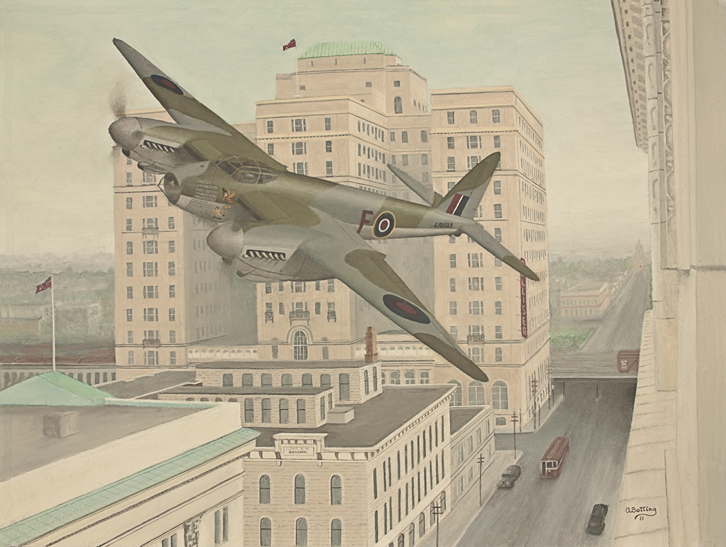 Bomber Command
Bomber Command  |
Aircrew Chronicles
|
Aircrew Losses
|
Nose Art
|
BCATP
|
Lancaster
|
Media
|
Aircrew Chronicles
|
Aircrew Losses
|
Nose Art
|
BCATP
|
Lancaster
|
Media
 Bomber Command
Bomber Command  |
Aircrew Chronicles
|
Aircrew Losses
|
Nose Art
|
BCATP
|
Lancaster
|
Media
|
Aircrew Chronicles
|
Aircrew Losses
|
Nose Art
|
BCATP
|
Lancaster
|
Media
|
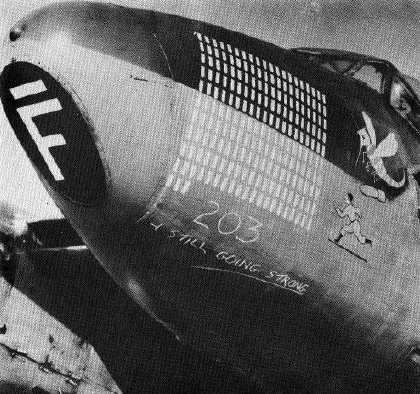
|
The VE Day sounds of celebration, revelry and relief were given new life when the stirring bass tones of two Merlin engines at full power caught the attention of Calgarians on the afternoon of May 9, 1945. One of their wartime adopted sons was home for a visit with a very special guest of honour; Mosquito LR503, known as 'F for Freddie'. This powerful, beautiful airplane, late of 105 Squadron, was the survivor of 213 operations over occupied Europe: More ops than any other allied bomber during World War II.
In one of the poignant and painful ironies of war, 24 hours later would see the crew dead and the remains of Freddie, a few bits of metal and smoking splinters, scattered across the airport.
Freddie's pilot that day was F/Lt. J. Maurice W. Briggs, DFM, DFC, and DSO. Just two years earlier, Briggs had left Calgary with his newly earned wings from #37 S.F.T.S.
Seated beside Briggs on his return to Calgary was F/O John C. Baker, DFC and Bar. Having successfully navigated them to Calgary, Baker could do no more than hang on and try to enjoy the ride as Briggs dove for the streets of downtown Calgary.
Those Calgarians who witnessed Briggs's flying display have never forgotten it. "Spectacular, exciting, frightening" and "amazing" are some of the words Neil Jonathan used to describe the spectacle more than fifty years later. R.C.A.F. staff working on the sixth floor of the Hudson Bay building recall having to look down to see the Mosquito streaking past their windows at over 300 mph.
While discussing the 'beat up' with a reporter later that day, Briggs admitted he didn't know how he missed the flagpole atop the eleven story landmark Palliser Hotel.
Air Traffic Controller, Peter Minchuk described how Briggs flew Freddie under a trestle which spanned 9th Avenue, two blocks west of the Palliser.
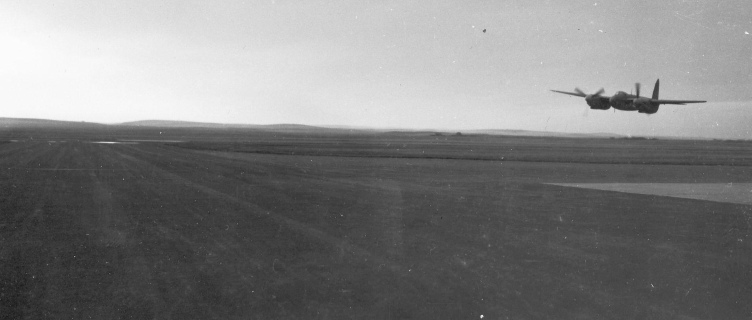
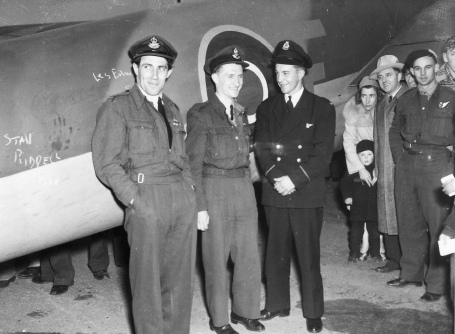 [Glenbow Museum Archive] |
Just after landing at Calgary on May 9, 1945. Maurice Briggs, John Baker and Edward Jack pose in front of Mosquito "F-for-Freddie". Members of the public who bought war bonds in support of the 8th Victory Loan Drive were allowed to chalk their names on the aircraft. |
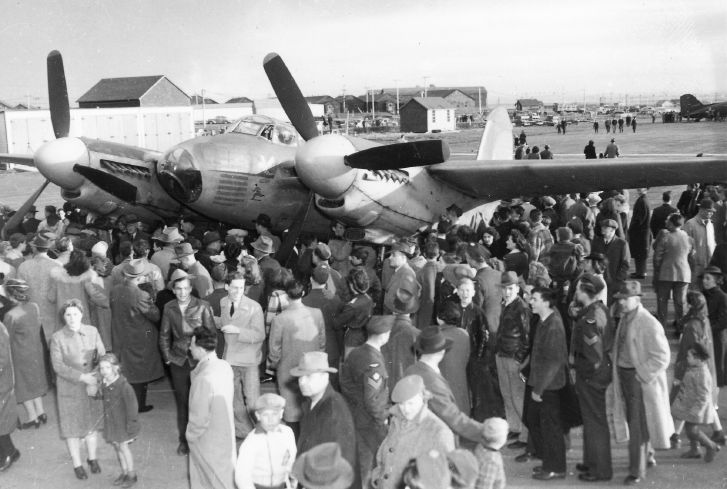
The Mosquito known as "Freddie" didn't start out life as 'Freddie' at all: For most of its life, "Freddie" was known as "Charlie". Before acquiring any name at all, the airplane began life as one of a batch of twenty two B. Mk. IX Mosquitos built at de Havilland's Hatfield facility in early 1943.
LR503 joined 109 Squadron, Path Finder Force on May 28, 1943 at Wyton, Huntingdonshire where it was known as "Charlie" after being assigned the letter "C" as its individual identifier.
On June 21, 1943, LR503 took off on the first of its 213 combat operations. It was one of twelve Mosquitos assigned to mark targets in the Ruhr city of Krefeld for 693 heavy bombers.
On March 10, 1944, LR503 was transferred to 105 Squadron, stationed at RAF Bourn. 109 Squadron's "HS" code letters were replaced by 105 Squadron's "GB". Initially, LR503 retained its individual identifying letter "C".
In less than a year from its first combat op to Krefeld, LR503 racked up its first hundred ops. F/Lt. H .D. 'Bill' Riley DFC and Bar, a navigator with 105 Squadron, notes in his logbook on the night of June 3, 1944 that LR503, reached its 100th op with a flight to Calais to drop three red target indicators.
That same page in Riley's log book also records LR503's contributions to D-Day operations. At 02:55 on the morning of the 6th of June, Riley along with his pilot F/Lt. Cliff Chadwick took off to drop target indicators at Longues-Sur-Mer, where a battery of artillery covered both the Omaha and Gold beaches.
Riley and Chadwick made a second trip on D-Day with LR503 to St. Lo with three red target indicators. After this trip Riley remarked on the significance of this day in his log book with a note which reads "INVASION HERE 'D' DAY".
Another navigator with 105 Squadron, John Sampson DFC, flew several ops in LR503 in the autumn and winter of 1944-45 and notes that by this time, LR503 carried the individual aircraft code letter "F" with a bar above the letter. The bar designation came about later in the war when squadrons had more than 26 aircraft on strength and letters had to be assigned to more than one aircraft, hence the 27th aircraft became "A" bar.
John Sampson remarked that "At 105 we did not go in for 'Nose Art' or mission credits but an exception was made in the case of LR503 because of its unique history. I remember this being discussed on the squadron as no one appeared to know what a mosquito (insect) looked like. I believe that the assistance of the Station Medical Officer was sought."
From its 100th trip on June 3, 1944 to its 213th and last combat operation on April 10, 1945, to the Wehren marshalling yards at Leipzig, Freddie average just over one trip every three days. When early in May a Mosquito was needed to fly to Canada to support the 8th Victory Loan Drive, Briggs and Baker were told to take F for Freddie after its sister ship, "D Dog" failed to make the Atlantic crossing because of mechanical problems. Baker, Briggs and "F-for-Freddie" at de Havilland Canada's Downsview base in Ontario on May 6, 1945. Note the peeling paint on the spinner. DHC did some servicing and retouching work before the boys headed west to Calgary. |
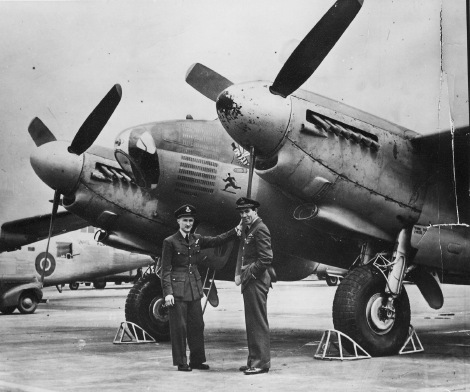 [Globe and Mail] |
It had been a long war for Maurice Briggs. He joined the RAF in 1938 when he was just 17. At the start of hostilities on September1, 1939 Briggs was an Air Gunner/Observer with 77 Squadron. His first taste of war came just days later when Whitleys from 77 Squadron flew on a 'Nickelling raid', dropping leaflets on cities in the Ruhr valley. Briggs completed his tour with distinction in September 1940 and was awarded a DFM. In April 1942 Briggs was sent to #13 Initial Training Wing (I.T.W.) at Torquay to begin pilot training, where in the Livermead Hotel he met and befriended fellow student F/Lt. A.J. 'Alf' Smitz, DFC. Training days: Maurice Briggs, Alf Smitz (at the wheel) and their colleague Brighouse, on leave from #37 SFTS in January 1943, en route from Calgary to Banff, Alberta, where Smitz met his future wife. That spring, the men returned to England and the war. |
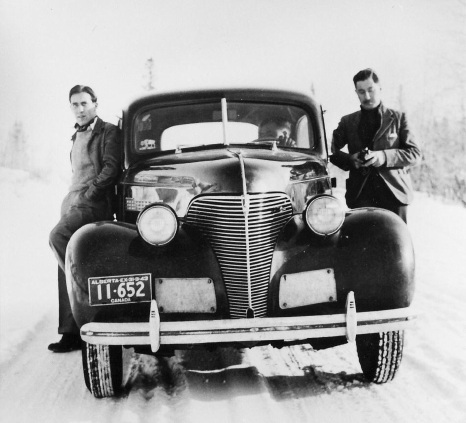 [A.J. Smith] |
Briggs and Smitz were next sent to Canada to continue their training, first at #32 EFTS at Bowden, Alberta and then on to #37 SFTS at Calgary.
Beyond learning to fly, the time in Calgary was eventful for Briggs and Smitz. Being an affable and charming character, Briggs made many friends and dated a number of young ladies. Smitz took a more permanent approach, when on a weekend leave he met Anne Littleton in the Banff Springs Hotel. They were married three months later. To thwart her disapproving parents' attempts to prevent the wedding, Briggs helped plan a ruse before standing up as best man at the wedding. Briggs later became godfather to their first child, Peter Smitz who was born in London just before D Day.
On April 2, 1943, eleven days after the wedding, Briggs and Smitz received their wings in the Drill Hall of #37 SFTS.
With mailing addresses, wedding rings and pilot's wings in hand, it was time for Briggs and Smitz to return to England and to the war. Both men spent the balance of the war piloting Mosquitos: Smitz with 141 Squadron and Briggs with 1409 Met Flight where, with his navigator Baker, they flew solo daylight ops, gathering weather data for Bomber Command planners.
After completing 108 trips with 1409 Flight and earning a DFC and a DSO, Briggs flew his last combat op of the war on December 7, 1944. Over the next few months, he and Baker made several trips to Canada to ferry Mosquitos from the de Havilland plant at Downs- view, Ontario back to England.
On May 5, 1945, Briggs and Baker finally joined up with F for Freddie when the pair was detailed to take the airplane to Canada in support of a war bond drive after their first assigned aircraft broke down enroute.
When Freddie and its crew arrived at Downsview on May 6, de Havilland supplied a resourceful engineer in the person of Edward Jack to look after the airplane's mechanical needs as they flew a series of half and one day stops across the country.
And so it was that on the afternoon of May 9, 1945, Calgarians thrilled to the sight of WWII's most accomplished bomber buzzing their city in a celebration to mark the end of the European war. Hundreds thronged to the airport to see this famous airplane and to meet its crew. For some, like Evelyn Powlan who had met him two years prior, it was a chance to reconnect with Maurice Briggs. For others, it was an opportunity to buy a bond and sign their names in chalk on the famous F for Freddie.
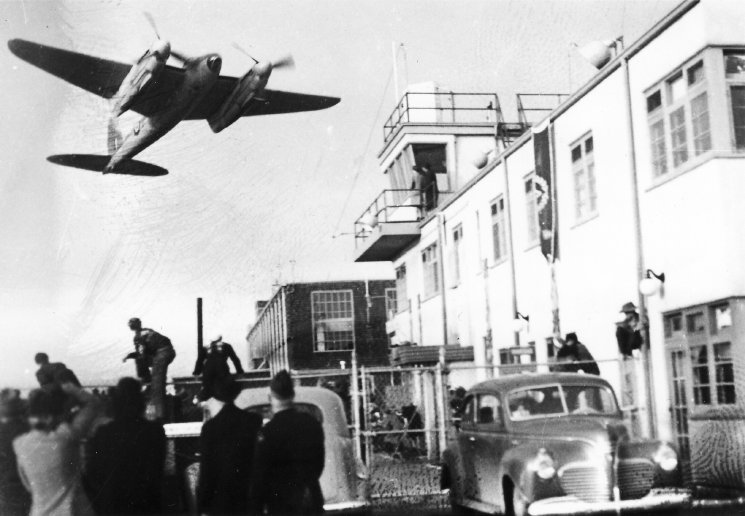
The next day Briggs and Baker were scheduled to fly Freddie on a triangular route over flying Penhold, 80 miles to the north, then south to the RCAF bases at Lethbridge and Medicine Hat, before returning to Calgary for the night.
When Briggs and Baker arrived at the airport, they found Edward Jack busy with the top cowlings removed from both of Freddie's engines. Their departure was delayed for an hour and a half by the mechanical problems.
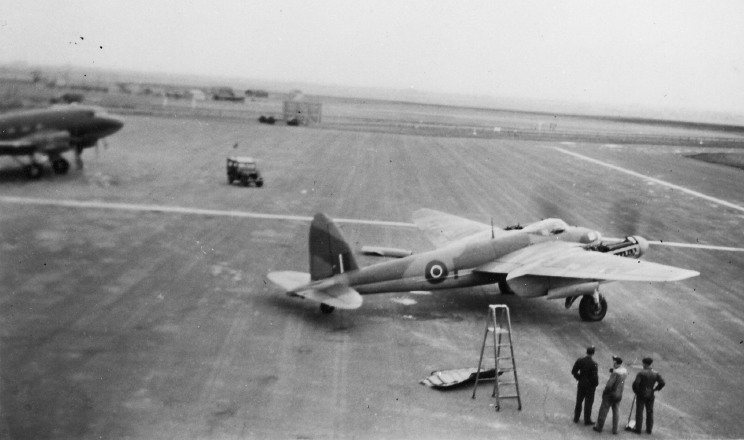
Finally, just before 16:00, Jack declared the airplane fit to fly. As he stood talking to Briggs, he suddenly felt ill. Though he was scheduled to take the right seat for the trip that afternoon, Briggs suggested that he might be better off sitting this one out. Jack agreed and then climbed the stairs to the control tower to watch them take off.
With a brisk wind blowing from the north, Briggs took off headed in that direction. As he had done several times the day before, Briggs turned back toward the terminal building and its rooftop control tower for a low altitude, high speed pass.
As the airplane got within 300 ft of the building, flying straight for them at near 400 mph, Harry McCaully, who was working in the tower, turned to his assistant Charles Hamilton and exclaimed "I'm looking down on him!" As McCaully related in 1993, "The airplane rose quickly; just making it above the tower".
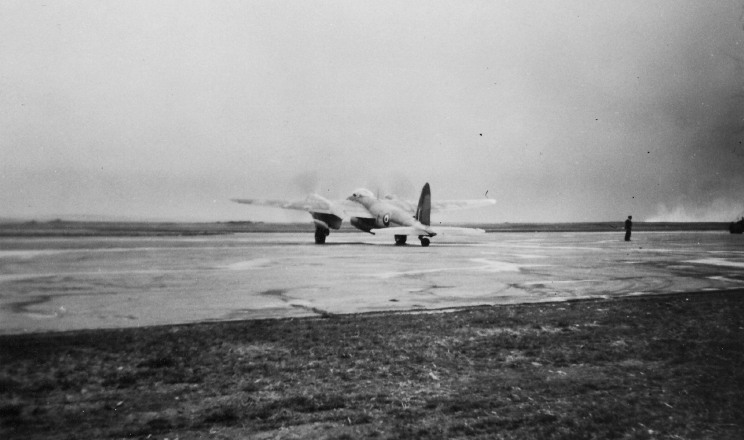
Briggs took Freddie south and circled back for a second pass on the 13 Calgary Mosquito Society building and the few dozen spectators who had come to see them off. As he completed a figure 8 and headed north for Penhold, Briggs came back on the tower frequency, telling controller Peter Minchuk that he had spotted a car just pulling up and that he was going to do one more pass for the friend he saw getting out of the car.
Diving back to ground level, Briggs again pointed Freddie straight at the terminal building, pulling up to clear the control tower at the last possible moment. This time he cleared the building, but hit the steel anemometer tower and flag pole on top of the control tower.
Harry McCaully exclaimed "My god!" and ran across the room toward the stairs. Edward Jack had already left the tower and was on the stairs. He later recalled feeling the building 'shudder' and hearing a 'thud'.
The impact with the metal poles sheared the port wing and horizontal stabilizer from the airplane. The upward angle and high speed carried the balance of Freddie and its crew over the 'H' huts of #37 SFTS and into a field almost half a mile from the terminal building. It struck at a shallow angle and exploded into flames, trailing wreckage and igniting the grass for over 300 yards.
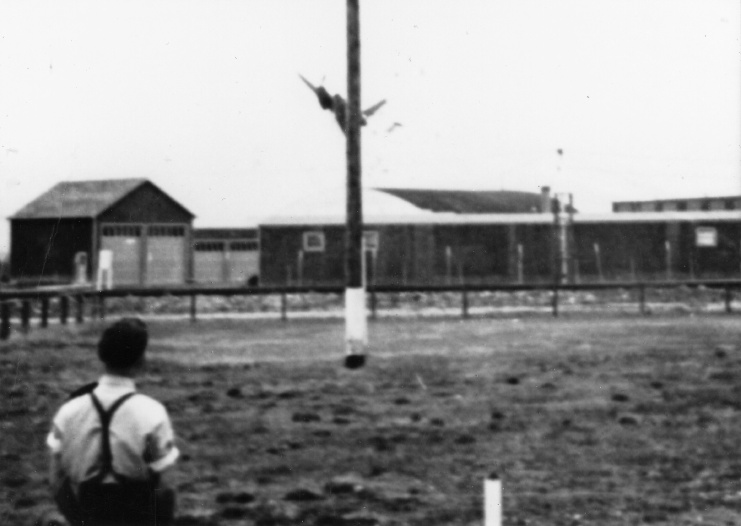
The first people on the scene found Briggs and Baker face down, side by side, thrown clear from the wreckage, but ablaze in their gasoline soaked uniforms.
Briggs had just celebrated his 25th birthday the previous Sunday in Downsview.
Mrs. G. L. Williams ran the lunch counter in the terminal building. She found Edward Jack and poured him some coffee and brandy; then she and her husband drove him back to his hotel. Enroute, Jack told the Williams' how he had just missed death by what he called "blind luck".
Then, according to Mrs. Williams, Jack just kept repeating over and over, "They were grand boys".
Although she saw the airplane hit the metal poles, Evelyn Powlan didn't find out that Briggs and Baker were killed until a reporter interviewing her about the accident confirmed their deaths. Airport Manager Cyrl Huntley telephoned the station commander Group Captain Irwin, then noted in his daily journal simply that "F for Freddie Crashed. 1620 M.D". (Mountain Daylight). A fireman detailed to help with the cleanup removed a narrow 4 inch long strip of grey painted plywood and a patch of fabric 6 inches square from the crash site. That night he penciled on the fabric: "Wing fabric from 'F for Freddie'. Most famous World War II Mosquito dive bomber. Ripped off wing as it crashed and fell. May 10, 1945". Two days later the Union Jack draped coffins, adorned simply with the crew's hats and a single rose each, were escorted by an honour guard of 100 airmen from the overfilled church, to the Field of Honour in Burnsland Cemetery where they were laid to rest. The only known remains of Mosquito "F-for-Freddie": a 4in scrap of plywood and a 6in square of fabric. They were brought into the Calgary Aero Space Museum in 1990 by the daughter of a fireman who salvaged them at the time of the crash. |
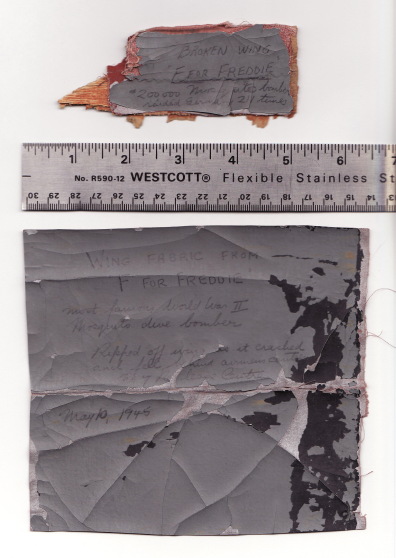 [Richard de Boer] |
Edward Jack returned to the Burnsland Cemetery on Remembrance Day, 1973. "I knew by all odds that I should have died in that plane too" he said. "Although I relived that day a thousand times, until now I couldn't bring myself to go back to the graveyard where I too would have been buried".
In 1991, the daughter of the fireman who had salvaged two souvenir scraps from the burned remains of F for Freddie made her way to what had been the Drill Hall for #37 SFTS. There she asked the staff of the Aero Space Museum of Calgary if they knew anything about the airplane, and if they wanted to add these pieces to their collection.
The following year, Maurice Briggs's godson Peter Smitz, then a RCMP officer stationed at the Calgary International Airport, came into the museum with newspaper clippings, given to him by his mother Anne, detailing the crash of an airplane and the death of a friend around VE Day in 1945.
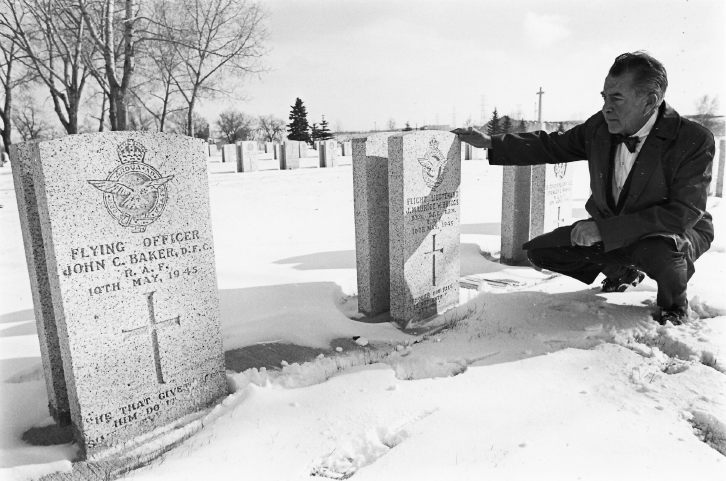
When I telephoned Anne Harder (nee Littleton) at her home in California where she had been living since 1948, we discovered that despite the separation of 35 years, she and I had grown up in the same neighborhood in Calgary and that we had gone to some of the same schools. I told her that the flying school where I earned my pilot's license now occupied the old terminal building and that when I started working for the Aero Space Museum that my office was also in that building. I told her that the museum now occupied the old Drill Hall and that it had a Mosquito in its collection; one of only 30 or so left in the world and that I would dearly love to see it restored as a tribute to Maurice, John and Freddie.
Anne asked if I ever went skiing and if I knew the Banff Springs Hotel. Then she began to tell me about being young, a little reckless and in love. She told me about a world at war and about the coming of peace after VE Day.
